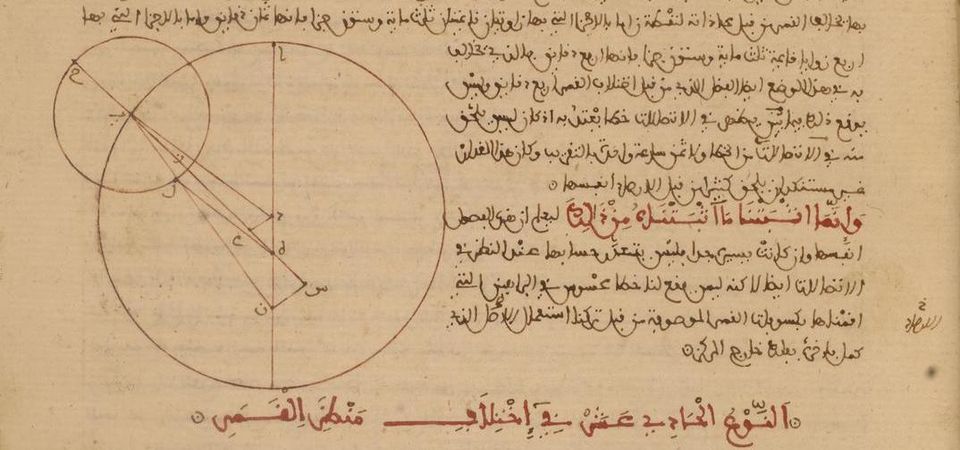A Syntaxia Mathematica

Many English words that start with al are loan words from Arabic. (Or, in some cases, words that were modified to seem like they were Arabic, such as almond). In Arabic, al is just the definite article the, as in Al Jezeera ("the island", i.e. the Arabian Peninsula) or Al Qaeda ("the base"). And so a lot of al- words have fairly pedestrian etymologies: alcove simply means 'the chamber', for example, while alkanet (the flower) means 'the henna'.

A wider survey of these words, however, will reveal a bit of a pattern of scientific and mathematical knowledge that was transmitted to Europeans by way of the Arabians[1]:
- alchemy – 'the chemistry'
- alembic – 'the distilling flask'
- alkali – 'the ashes', the basis of the word alkaline, which refers to compounds like potassium carbonate that are basic in the chemical sense
- almanac – 'the calendar' (disputed etymology)
- alkahest – 'the universal solvent' (another pseudo-Arabic word, like almond)
- alcohol – 'the khol' (named for the finely-powdered cosmetic and, by way of analogy, the distilled essence of any substance, i.e. ethanol is "the khol of wine").
- algebra – 'the calculation', from the famous mathematical treaty by Baghdad scholar Abu Ja'far Muhammad ibn Musa al-Khwarizmi, Al-kitāb al-mukhtaṣar fī ḥisāb al-ğabr wa’l-muqābala, or, The Compendious Book on Calculation by Completion and Balancing.
- algorithm – 'the [native of] Khwarazm', from the last name of the aforementioned mathematician, which came into its current meaning by way of a curious transliteration from Arabic via mangled Ancient Greek, Medieval Latin and Old French.
The Magestic Treatise
Claudius Ptolemy (known to his mother as Klaúdios Ptolemaîos) was a scholar who lived and worked in the city of Alexandria in the Second Century CE. He wrote a book – which he gave the Greek title Mathēmatikē Syntaxis, or the Systematic Mathematical [Treatise] – that went on to become the standard textbook of astronomy from the Fourth Century to the Sixteenth Century. It is in this book that he developed a simple geometric model for the solar system, which predicts the apparent motions of the sun, moon, planets and stars to a reasonable degree of accuracy given the quality of observations he had access to at the time.
Ptolemy was not Arabic, but his legendary treatise is known to us as the Almagest, which is a transliteration of its Arabic title al-mjsty; literally, The Magestic. (As in, The Magestic Treatise of Astronomy.) For the Arabian scholars who brought algebra, chemistry, astronomy, and Arabian numerals[2] to Western Europe, by way of Toledo, the Almagest was literally the greatest astronomical work in all existence. And it was thanks to their efforts of preservation that we not only have the book's current title, but that it was able to regain the prominance it held in Christendom which it lost in the fall of Byzantine.
A Syntaxia Miscellanica
The Almagest also has a Latin name which Ptolemy – as a citizen of Rome, and resident of the Roman province of Egypt – would have been perfectly familiar with: the Syntaxia Mathematica. It is from this title that I take the name of my blog, the purpose of which is to document my attempts to read, understand, and explain the Almagest.
This is no simple task, in part because the Almagest is complex enough that it would have been difficult for Ptolemy's own students to comprehend, but also because its dating conventions and trigonometric methodologies are helplessly archaic from the perspective of the unassisted modern reader. But my hope is that I can do some of the working, which others can follow, to develop an appreciation of the Almagest on its own merits.
I am not the first to make such an effort, and it is only remotely possible for me to make the attempt because so many have done so much to simplify the work already. And so, on that note, I will be relying heavily on G.J. Toomer's Ptolemy's Almagest (Duckworth: London, 1984) and Richard Fitzpatrick's A Modern Almagest (which is available freely at his University of Texas at Austin webpage). I also suspect I will, at some point, need to check out Glen Van Brummelen's Heavenly Mathematics (Princeton UP: Princeton, 2013) and his Early History of Trigonometry (Princeton UP: Princeton, 2009) to make some basic inroads in this endeavour.
But if you have suggestions for any other resources that may be useful to me, or know of anyone attempting a similar project, please feel free to comment below.
This blog is also a "Miscellanica", though, because it will have no clear structure, and I intend to get distracted a lot. So expect this to be a collection of miscellaneous articles which loosely focus on the Almagest, but will include lots of articles on culture, history, science, technology, literature, film, linguistics, and whatever else happens to take my fancy. There may also be a few reposts of some of my past blog articles, which I will probably back-date to their original date of publication, if only to give them a home again.
The Big Book
I like to joke that the title al-mjsty, or the Almagest, or whatever, is best translated as The Big Book of Astronomy. And this is partly a joke about the implied authoritative hyperbole of calling a textbook The Majestic, and also a joke on the Big Book of Science books that I encountered a lot of as a kid (which, I think, tried to be fairly authoritative in their own right).
But I also like the joke because I really like the Metronomy lyric, "We didn't read it in a Big Book." It's probably a throway line, to some extent, but it really gels with me. Because I'm about to read it in a Big Book. Ptolemy's book. Let's see how that goes.
Etymologies provided by the Online Etymology Dictionary, which is easily one of my favourite resources. ↩︎
Known to the Arabians themselves as arqam al hind, "figures from India". ↩︎



Comments ()